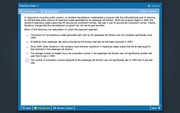In response to mounting public concern, an airplane manufacturer implemented a program with the well-publicized goal of reducing by half the total yearly amount of hazardouse waste generated by its passenger-jet division. When the program began in 1994, the division's hazardous waste output was 90 pounds per production worker; last year it was 40 pounds per production worker. Clearly, therefore, charges that the manufacturer's program has not met its goal are false.
Which of the following is an assumption on which the argument depends?
a) The amount of nonhazardous waste generated each year by the passenger-jet division has not increased significantly since 1994.
b) At least as many passenger jets were produced by the division last year as had been produced in 1994.
c) Since 1994, other divisions in the company have achieved reductions in hazardous waste output that are at least equal to that achieved in the passenger-jet division.
d) The average number of weekly hours per production worker in the passenger-jet division was not significantly greater last year than it was in 1994.
e) The number of production workers assigned to the passenger-jet division was not significantly less in 1994 than it was last year.
Premise:
In 1994, (total waste)/(total number of workers) = 90/1.
Last year, (total waste)/(total number of workers) = 40/1.
Conclusion:
From 1994 to last year, the manufacturer has met its goal of reducing by half the total amount of yearly waste.
The manufacture concludes that the decrease in the ratio -- from 90/1 to 40/1 -- is due to a decrease in the NUMERATOR (the amount of waste produced).
The assumption is that the decrease in the ratio is NOT due to an increase in the DENOMINATOR (the total number of workers)
.
Answer choice
E states this assumption:
The manufacturer assumes that
the number of production workers assigned to the passenger-jet division was not significantly less in 1994 than it was last year.
In other words, the manufacturer assumes that there was not an INCREASE IN THE NUMBER OF WORKERS.
The correct answer is
E.
Private tutor exclusively for the GMAT and GRE, with over 20 years of experience.
Followed here and elsewhere by over 1900 test-takers.
I have worked with students based in the US, Australia, Taiwan, China, Tajikistan, Kuwait, Saudi Arabia -- a long list of countries.
My students have been admitted to HBS, CBS, Tuck, Yale, Stern, Fuqua -- a long list of top programs.
As a tutor, I don't simply teach you how I would approach problems.
I unlock the best way for YOU to solve problems.
For more information, please email me (Mitch Hunt) at
[email protected].
Student Review #1
Student Review #2
Student Review #3